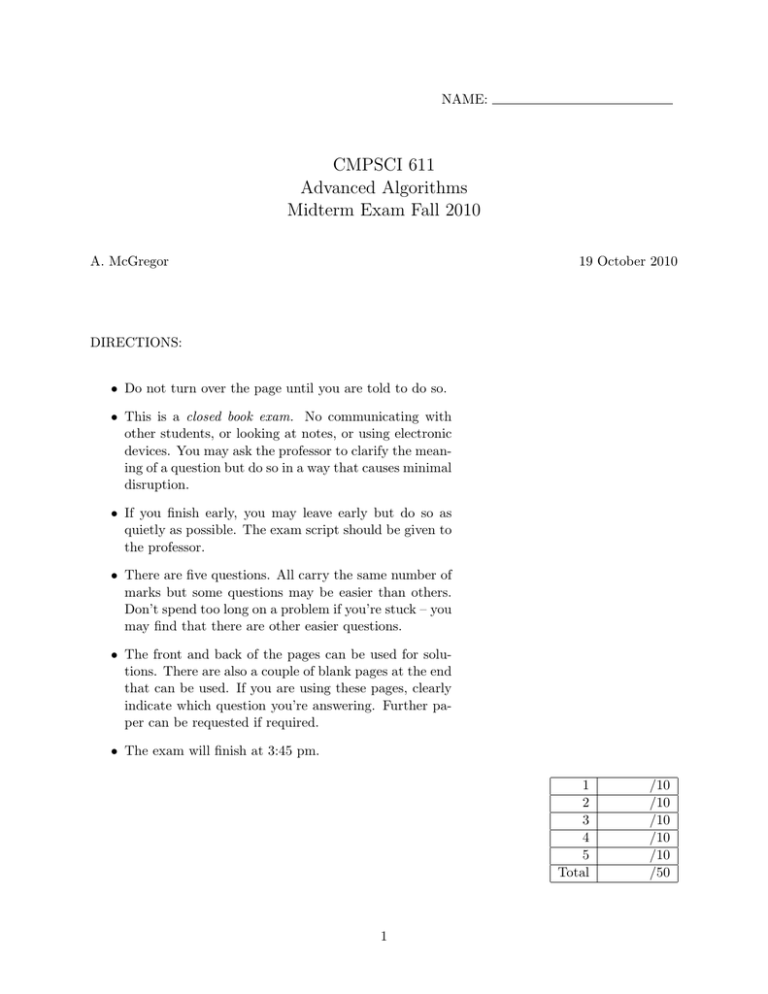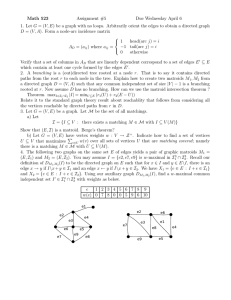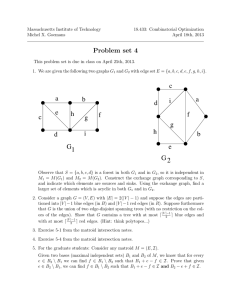Solutions
advertisement

NAME:
CMPSCI 611
Advanced Algorithms
Midterm Exam Fall 2010
A. McGregor
19 October 2010
DIRECTIONS:
• Do not turn over the page until you are told to do so.
• This is a closed book exam. No communicating with
other students, or looking at notes, or using electronic
devices. You may ask the professor to clarify the meaning of a question but do so in a way that causes minimal
disruption.
• If you finish early, you may leave early but do so as
quietly as possible. The exam script should be given to
the professor.
• There are five questions. All carry the same number of
marks but some questions may be easier than others.
Don’t spend too long on a problem if you’re stuck – you
may find that there are other easier questions.
• The front and back of the pages can be used for solutions. There are also a couple of blank pages at the end
that can be used. If you are using these pages, clearly
indicate which question you’re answering. Further paper can be requested if required.
• The exam will finish at 3:45 pm.
1
2
3
4
5
Total
1
/10
/10
/10
/10
/10
/50
Question 1: In the first part of this question, consider the following undirected graph where the
value of each edge represents the length of that edge:
99
v1
3
v4
5
v5
9
v2
v3
4
4
3
2
v6
20
v7
5
1. What is the total length of the shortest path between v1 and v3 ?
ANSWER: 3+5+5+3=16
2. What is the total length of the edges in a minimum spanning tree?
ANSWER: Edges of a MST are (v5 , v6 ), (v1 , v5 ), (v3 , v7 ), (v5 , v2 ), (v4 , v5 ), (v4 , v7 ). Total
weight is 2 + 3 + 3 + 4 + 5 + 5 = 22.
The next part of this question concerns an arbitrary weighted, undirected graph. For any
two nodes u and v let δG (u, v) denote the length of the shortest path between u and v in
the graph G. For each of the following statements, write whether they are true or false (no
proofs required although including good reasoning may get partial credit even if you get the
final answer wrong):
3. δT (u, v) = δG (u, v) if T is a minimum spanning tree of G.
FALSE. Consider the graph G with nodes {v1 , v2 , v3 } and edges {(v1 , v2 ), (v2 , v3 ), (v3 , v1 )}
where each edge has weight 1. All distances in G are 1 but in the minimum spanning
tree, there is at least once pair of nodes that are distance 2 apart.
4. δG (u, v) ≤ δG (u, w) implies δG0 (u, v) ≤ δG0 (u, w) where G0 is the graph formed by adding
1 to each of the edge lengths in G.
FALSE. Consider the graph with nodes {v, x, u, w} and edges {(v, x), (x, u), (u, w)} with
weights 1,1, and 2.5 respectively.
5. δG (u, v) ≤ δG (u, w) implies δG00 (u, v) ≤ δG00 (u, w) where G00 is the graph formed by
doubling each of the edge lengths in G.
TRUE.
2
Question 2: This question is about the subset system (E, I) where:
E = {a, b, c, d}
I = {∅, {a}, {b}, {c}, {d}, {a, b}, {a, c}, {b, c}, {c, d}, {a, b, c}}
1. List all the maximal subsets in I. Why can you conclude that (E, I) is not a matroid?
ANSWER: The maximal subsets are {c, d} and {a, b, c}. If the subset system was a
matroid, all the maximal subsets would have the same cardinality. So the subset system
is not a matroid.
2. Consider the weighting function w(a) = 1, w(b) = 2, w(c) = 3, and w(d) = 4. What
solution is returned by the greedy algorithm? How does this compare to the optimal
solution?
ANSWER: The greedy solution is {c, d} and this has weight 7. This is the optimal
solution!
3. Specify a weight function w on E such that the greedy algorithm doesn’t return an
optimal solution. Include the greedy solution and the optimal solution in your answer.
ANSWER: Consider the weight function w(a) = w(b) = w(c) = 2 and w(d) = 3. The
greedy solution is {c, d} and this has weight 5. The optimal solution is {a, b, c} and this
has weight 6.
4. Identify two subsets i, j ⊂ E such that (E, I + i + j) is a matroid.
ANSWER: Add the subsets {b.d} and {d, b, c}.
3
Question 3: Give a linear-time algorithm that takes as input a tree T and determines whether it
has a perfect matching, i.e., whether there exists a subset of edges that touches each node
exactly once.
ANSWER: Let V and E be the vertices and edges of T and let n = |V |. Consider the following
algorithm:
1. M ← ∅
2. While E 6= ∅:
(a) Let v ∈ V be a leaf (i.e., a node of degree 1) and let (u, v) ∈ E be the unique edge
incident on v
(b) M ← M + (u, v)
(c) V ← V − u − v and remove all edges from E that are incident on u or v
3. If |M | = n/2 return “perfect matching” and if not, return “not perfect matching”
We first note that M is always a matching because whenever an edge e is added to M , all the
edges sharing an endpoint with e are removed from the graph and therefore cannot subsequently
be added to M . Hence if |M | = n/2, then we indeed have a perfect matching. Consequently
we never return “perfect matching” if T does not have a perfect matching.
It remains to show that if T has a perfect matching then we return “perfect matching”. Assume
M ∗ is such a matching. If v is a leaf and (u, v) ∈ E then (u, v) must be in M ∗ since otherwise
v will not be covered. Hence, without loss of generality we may add (u, v) to M and remove
all other edges incident on u. After removing u and v from V , the resulting subgraph has a
perfect matching and we may recurse on this graph. In this way we find all the edges of M ∗
and hence |M | = |M ∗ | = n/2.
4
Question 4: A subsequence is palindromic if it is the same whether read left to right or right to
left. For instance, the sequence
A, C, G, T, G, T, C, A, A, A, A, T, C, G
has many palindromic subsequences, including A, C, G, C, A and A, A, A, A. Devise an algorithm that takes a sequence x1 , x2 , . . . , xn and returns the length of the longest palindromic
subsequence. For full marks the running time should be O(n2 ) but partial marks are available
for less efficient solutions.
Hint: Let A[i, k] be the length of the longest palindromic subsequence of xi , xi+1 , . . . xi+k−1
and consider computing A[1, n] via dynamic programming.
ANSWER: Since a subsequence of length 1 is palindromic, A[i, 1] = 1 for all i. For i ∈ [n]
and k ∈ {2, . . . , n − i + 1}
(
max(A[i, k − 1], A[i + 1, k − 1]) if xi 6= xi+k−1
A[i, k] =
2 + A[i + 1, k − 2]
if xi = xi+k−1
The rationale for the formula is that the longest palindromic subsequence of xi , xi+1 , . . . , xi+k−1
either includes xi and xi+k−1 (in which case they must be equal) or it doesn’t. If it doesn’t
the longest palindromic subsequence of xi , xi+1 , . . . , xi+k−1 is also a palindromic subsequence
of xi+1 , . . . , xi+k−1 or xi , . . . , xi+k−2 . It it does then A[i, k] is 2 + A[i + 1, k − 2].
Hence A[1, n] can be constructed by the following algorithm:
1. For all i ∈ [n], let A[i, 1] = 1
2. For all i ∈ [n], let A[i, 2] = 2 if xi = xi+1 and A[i, 2] = 1 otherwise
3. For k = 3 to n:
(a) For i = 1 to n − k + 1:
(
max(A[i, k − 1], A[i + 1, k − 1])
A[i, k] =
2 + A[i + 1, k − 2]
if xi 6= xj
if xi = xj
4. Return A[1, n]
The running time is clearly O(n2 ) since there are O(n2 ) values to be computed and each
requires O(1) time.
5
Question 5: Given a sorted list of distinct integers A[1], A[2], . . . , A[n], you want to find out
whether there is an index i for which A[i] = i. Give an algorithm that runs in time O(log n).
Remember to prove that your algorithm is correct and analyze the running time.
For example, A = [−1, 1, 3, 5, 6, 7] does have such an index, i.e., A[3] = 3.
[0, 1, 2, 5, 6, 7] doesn’t have such an index.
But A =
ANSWER: Consider the following algorithm.
1. a ← 1
2. b ← n
3. While b − a + 1 ≥ 3
(a) k ← d(a + b)/2e
(b) If A[k] = k then return YES!
(c) If A[k] < k then a ← k + 1
(d) If A[k] > k then b ← k − 1
4. If A[a] = a, A[a + 1] = a + 1, or A[a + 2] = a + 2 then return YES! Otherwise NO!
The running time is O(log n). This follows because the value of b − a + 1 decreases by a factor 2 in
each iteration. Let ai and bi be the values of a and b at the start of the i-th iteration. Then
bi+1 − ai+1 + 1 ≤ max(bi − k, k − ai ) ≤ (bi − ai + 1)/2
Hence, there are at most O(log n) iterations. Because each iteration takes O(1) time, the total
running time is as claimed.
We now prove correctness. Note that we can never report YES when the answer is NO because
we only answer YES when a test A[i] = i is passed for some i. It remains to prove that we never
answer NO when the answer should be YES. To do this we prove that if there exists i ∈ [n] such
that A[i] = i, then at any point of the algorithm the values of a and b satisfy a ≤ i ≤ b. We show
this by induction on the number of times the while loop is performed. Before the loop is performed,
a = 1 and b = n and so the base case is trivially true. Assume that the claim is true before the jth
time the loop is performed. If A[k] < k then we know all ` ≤ k satisfy A[`] ≤ A[k] − (k − `) < ` and
i ≥ k + 1 as required. Similarly, if A[k] > k then we know all ` ≥ k satisfy A[`] ≥ A[k] + (` − k) > `
and hence i ≤ k − 1 as required. Therefore, either we find the fixed point during some iteration or
in the fourth line. Either way, we output YES.
6



